Positive and Negative Impacts of Tourism in Tokyo
VerifiedAdded on 2022/12/16
|10
|3241
|315
AI Summary
This article discusses the positive and negative impacts of tourism in Tokyo. It covers the economic, socio-cultural, and environmental effects on the destination. It also explores the attractions and accessibility of Tokyo for tourists.
Contribute Materials
Your contribution can guide someone’s learning journey. Share your
documents today.

ROADMAP TO
DESTINATION
SUCCESS
1
DESTINATION
SUCCESS
1
Secure Best Marks with AI Grader
Need help grading? Try our AI Grader for instant feedback on your assignments.
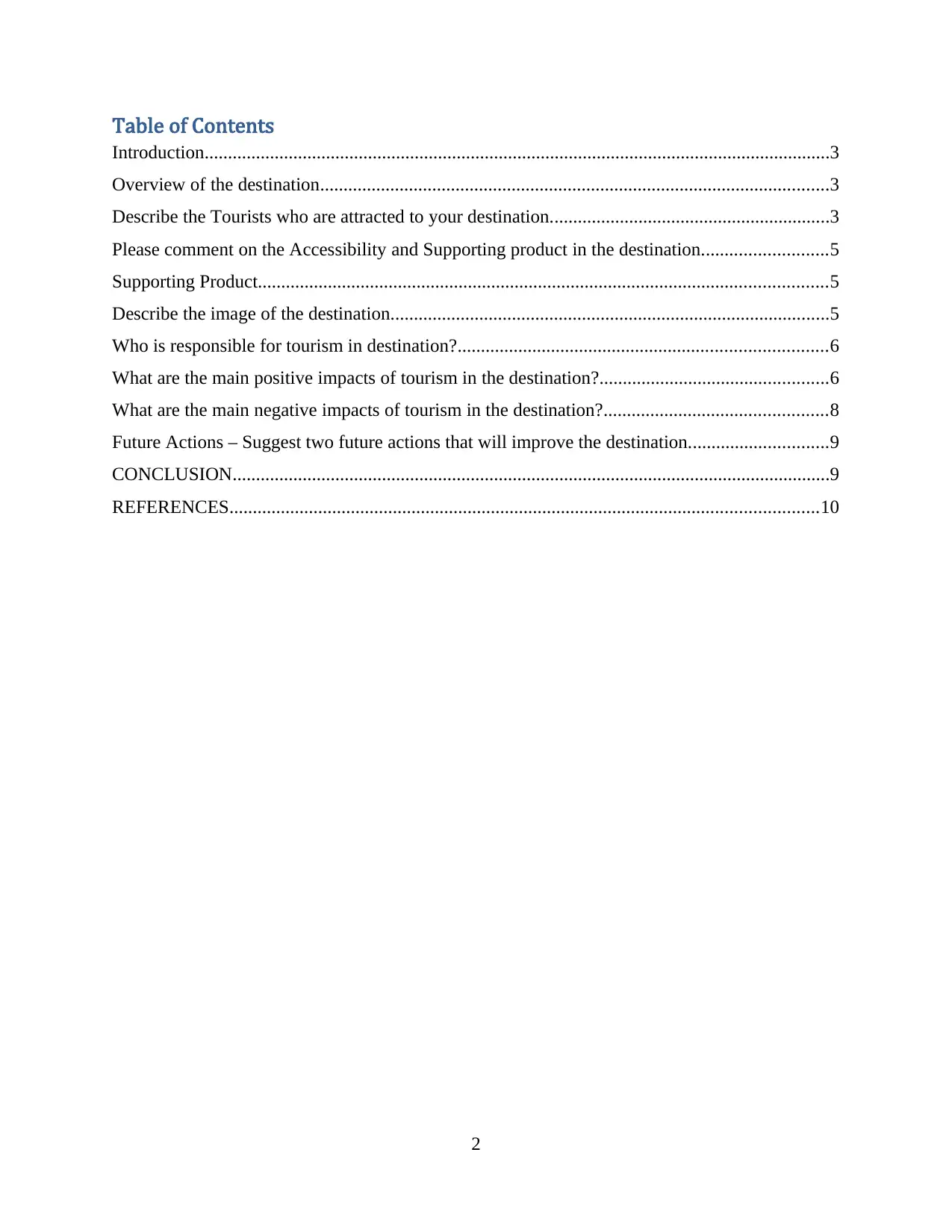
Table of Contents
Introduction......................................................................................................................................3
Overview of the destination.............................................................................................................3
Describe the Tourists who are attracted to your destination............................................................3
Please comment on the Accessibility and Supporting product in the destination...........................5
Supporting Product..........................................................................................................................5
Describe the image of the destination..............................................................................................5
Who is responsible for tourism in destination?...............................................................................6
What are the main positive impacts of tourism in the destination?.................................................6
What are the main negative impacts of tourism in the destination?................................................8
Future Actions – Suggest two future actions that will improve the destination..............................9
CONCLUSION................................................................................................................................9
REFERENCES..............................................................................................................................10
2
Introduction......................................................................................................................................3
Overview of the destination.............................................................................................................3
Describe the Tourists who are attracted to your destination............................................................3
Please comment on the Accessibility and Supporting product in the destination...........................5
Supporting Product..........................................................................................................................5
Describe the image of the destination..............................................................................................5
Who is responsible for tourism in destination?...............................................................................6
What are the main positive impacts of tourism in the destination?.................................................6
What are the main negative impacts of tourism in the destination?................................................8
Future Actions – Suggest two future actions that will improve the destination..............................9
CONCLUSION................................................................................................................................9
REFERENCES..............................................................................................................................10
2
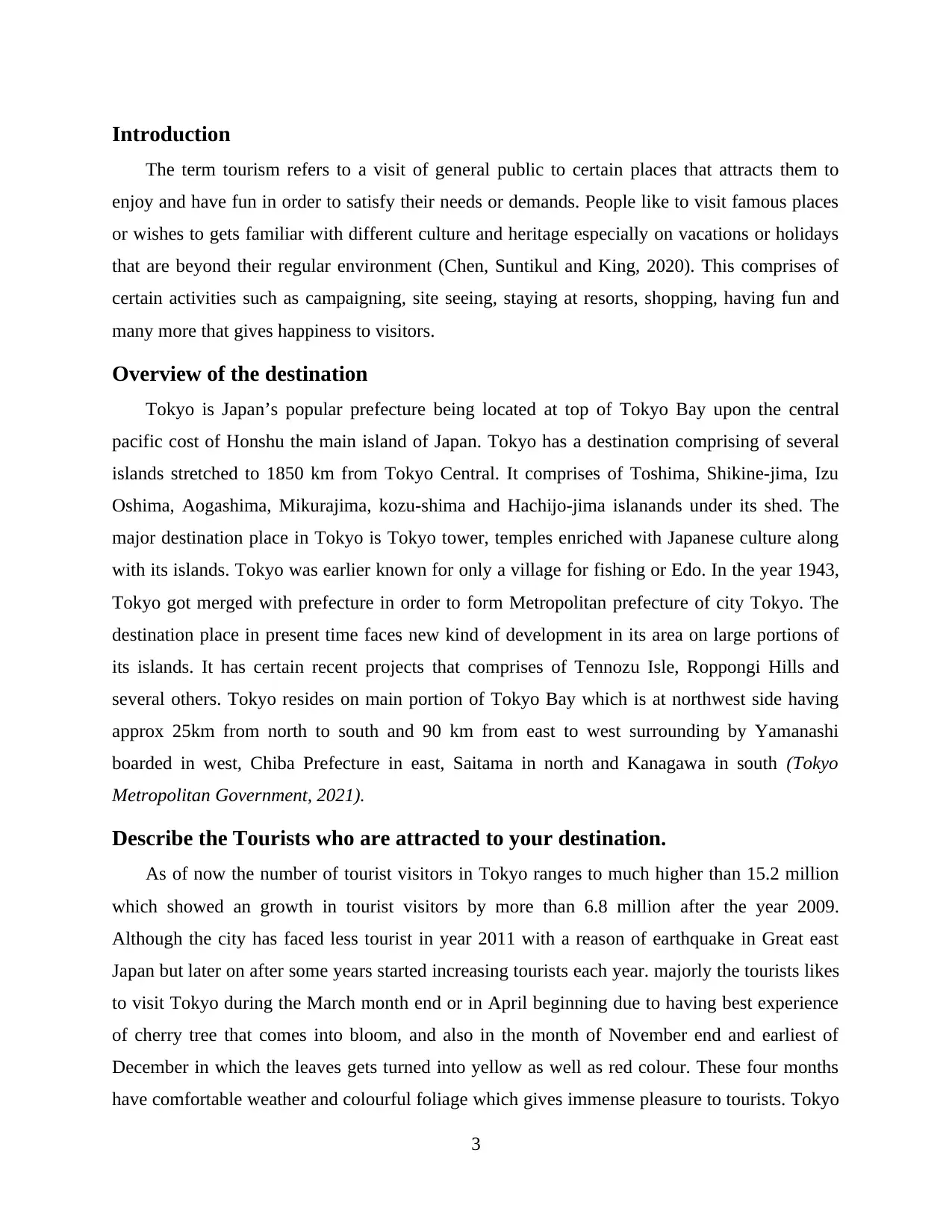
Introduction
The term tourism refers to a visit of general public to certain places that attracts them to
enjoy and have fun in order to satisfy their needs or demands. People like to visit famous places
or wishes to gets familiar with different culture and heritage especially on vacations or holidays
that are beyond their regular environment (Chen, Suntikul and King, 2020). This comprises of
certain activities such as campaigning, site seeing, staying at resorts, shopping, having fun and
many more that gives happiness to visitors.
Overview of the destination
Tokyo is Japan’s popular prefecture being located at top of Tokyo Bay upon the central
pacific cost of Honshu the main island of Japan. Tokyo has a destination comprising of several
islands stretched to 1850 km from Tokyo Central. It comprises of Toshima, Shikine-jima, Izu
Oshima, Aogashima, Mikurajima, kozu-shima and Hachijo-jima islanands under its shed. The
major destination place in Tokyo is Tokyo tower, temples enriched with Japanese culture along
with its islands. Tokyo was earlier known for only a village for fishing or Edo. In the year 1943,
Tokyo got merged with prefecture in order to form Metropolitan prefecture of city Tokyo. The
destination place in present time faces new kind of development in its area on large portions of
its islands. It has certain recent projects that comprises of Tennozu Isle, Roppongi Hills and
several others. Tokyo resides on main portion of Tokyo Bay which is at northwest side having
approx 25km from north to south and 90 km from east to west surrounding by Yamanashi
boarded in west, Chiba Prefecture in east, Saitama in north and Kanagawa in south (Tokyo
Metropolitan Government, 2021).
Describe the Tourists who are attracted to your destination.
As of now the number of tourist visitors in Tokyo ranges to much higher than 15.2 million
which showed an growth in tourist visitors by more than 6.8 million after the year 2009.
Although the city has faced less tourist in year 2011 with a reason of earthquake in Great east
Japan but later on after some years started increasing tourists each year. majorly the tourists likes
to visit Tokyo during the March month end or in April beginning due to having best experience
of cherry tree that comes into bloom, and also in the month of November end and earliest of
December in which the leaves gets turned into yellow as well as red colour. These four months
have comfortable weather and colourful foliage which gives immense pleasure to tourists. Tokyo
3
The term tourism refers to a visit of general public to certain places that attracts them to
enjoy and have fun in order to satisfy their needs or demands. People like to visit famous places
or wishes to gets familiar with different culture and heritage especially on vacations or holidays
that are beyond their regular environment (Chen, Suntikul and King, 2020). This comprises of
certain activities such as campaigning, site seeing, staying at resorts, shopping, having fun and
many more that gives happiness to visitors.
Overview of the destination
Tokyo is Japan’s popular prefecture being located at top of Tokyo Bay upon the central
pacific cost of Honshu the main island of Japan. Tokyo has a destination comprising of several
islands stretched to 1850 km from Tokyo Central. It comprises of Toshima, Shikine-jima, Izu
Oshima, Aogashima, Mikurajima, kozu-shima and Hachijo-jima islanands under its shed. The
major destination place in Tokyo is Tokyo tower, temples enriched with Japanese culture along
with its islands. Tokyo was earlier known for only a village for fishing or Edo. In the year 1943,
Tokyo got merged with prefecture in order to form Metropolitan prefecture of city Tokyo. The
destination place in present time faces new kind of development in its area on large portions of
its islands. It has certain recent projects that comprises of Tennozu Isle, Roppongi Hills and
several others. Tokyo resides on main portion of Tokyo Bay which is at northwest side having
approx 25km from north to south and 90 km from east to west surrounding by Yamanashi
boarded in west, Chiba Prefecture in east, Saitama in north and Kanagawa in south (Tokyo
Metropolitan Government, 2021).
Describe the Tourists who are attracted to your destination.
As of now the number of tourist visitors in Tokyo ranges to much higher than 15.2 million
which showed an growth in tourist visitors by more than 6.8 million after the year 2009.
Although the city has faced less tourist in year 2011 with a reason of earthquake in Great east
Japan but later on after some years started increasing tourists each year. majorly the tourists likes
to visit Tokyo during the March month end or in April beginning due to having best experience
of cherry tree that comes into bloom, and also in the month of November end and earliest of
December in which the leaves gets turned into yellow as well as red colour. These four months
have comfortable weather and colourful foliage which gives immense pleasure to tourists. Tokyo
3
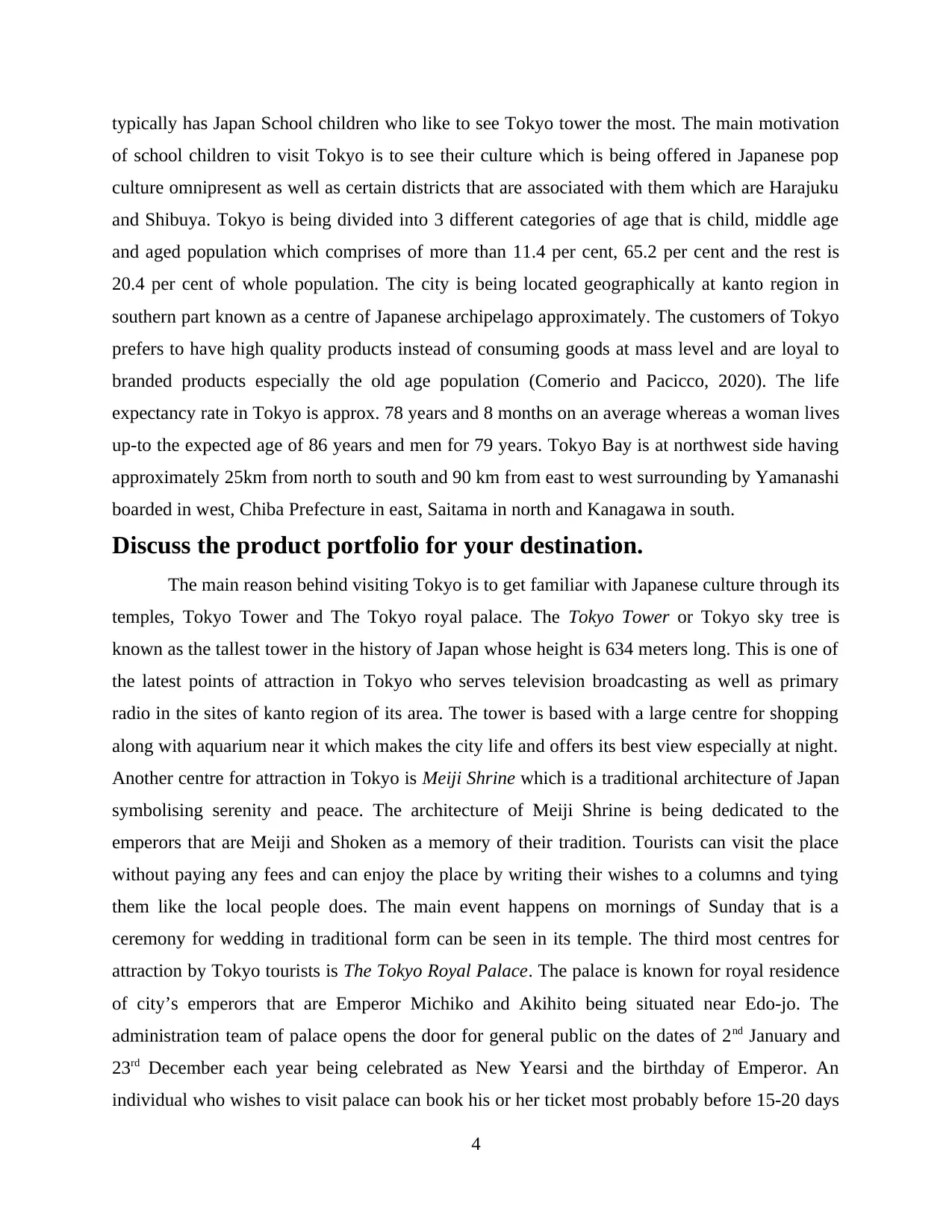
typically has Japan School children who like to see Tokyo tower the most. The main motivation
of school children to visit Tokyo is to see their culture which is being offered in Japanese pop
culture omnipresent as well as certain districts that are associated with them which are Harajuku
and Shibuya. Tokyo is being divided into 3 different categories of age that is child, middle age
and aged population which comprises of more than 11.4 per cent, 65.2 per cent and the rest is
20.4 per cent of whole population. The city is being located geographically at kanto region in
southern part known as a centre of Japanese archipelago approximately. The customers of Tokyo
prefers to have high quality products instead of consuming goods at mass level and are loyal to
branded products especially the old age population (Comerio and Pacicco, 2020). The life
expectancy rate in Tokyo is approx. 78 years and 8 months on an average whereas a woman lives
up-to the expected age of 86 years and men for 79 years. Tokyo Bay is at northwest side having
approximately 25km from north to south and 90 km from east to west surrounding by Yamanashi
boarded in west, Chiba Prefecture in east, Saitama in north and Kanagawa in south.
Discuss the product portfolio for your destination.
The main reason behind visiting Tokyo is to get familiar with Japanese culture through its
temples, Tokyo Tower and The Tokyo royal palace. The Tokyo Tower or Tokyo sky tree is
known as the tallest tower in the history of Japan whose height is 634 meters long. This is one of
the latest points of attraction in Tokyo who serves television broadcasting as well as primary
radio in the sites of kanto region of its area. The tower is based with a large centre for shopping
along with aquarium near it which makes the city life and offers its best view especially at night.
Another centre for attraction in Tokyo is Meiji Shrine which is a traditional architecture of Japan
symbolising serenity and peace. The architecture of Meiji Shrine is being dedicated to the
emperors that are Meiji and Shoken as a memory of their tradition. Tourists can visit the place
without paying any fees and can enjoy the place by writing their wishes to a columns and tying
them like the local people does. The main event happens on mornings of Sunday that is a
ceremony for wedding in traditional form can be seen in its temple. The third most centres for
attraction by Tokyo tourists is The Tokyo Royal Palace. The palace is known for royal residence
of city’s emperors that are Emperor Michiko and Akihito being situated near Edo-jo. The
administration team of palace opens the door for general public on the dates of 2nd January and
23rd December each year being celebrated as New Yearsi and the birthday of Emperor. An
individual who wishes to visit palace can book his or her ticket most probably before 15-20 days
4
of school children to visit Tokyo is to see their culture which is being offered in Japanese pop
culture omnipresent as well as certain districts that are associated with them which are Harajuku
and Shibuya. Tokyo is being divided into 3 different categories of age that is child, middle age
and aged population which comprises of more than 11.4 per cent, 65.2 per cent and the rest is
20.4 per cent of whole population. The city is being located geographically at kanto region in
southern part known as a centre of Japanese archipelago approximately. The customers of Tokyo
prefers to have high quality products instead of consuming goods at mass level and are loyal to
branded products especially the old age population (Comerio and Pacicco, 2020). The life
expectancy rate in Tokyo is approx. 78 years and 8 months on an average whereas a woman lives
up-to the expected age of 86 years and men for 79 years. Tokyo Bay is at northwest side having
approximately 25km from north to south and 90 km from east to west surrounding by Yamanashi
boarded in west, Chiba Prefecture in east, Saitama in north and Kanagawa in south.
Discuss the product portfolio for your destination.
The main reason behind visiting Tokyo is to get familiar with Japanese culture through its
temples, Tokyo Tower and The Tokyo royal palace. The Tokyo Tower or Tokyo sky tree is
known as the tallest tower in the history of Japan whose height is 634 meters long. This is one of
the latest points of attraction in Tokyo who serves television broadcasting as well as primary
radio in the sites of kanto region of its area. The tower is based with a large centre for shopping
along with aquarium near it which makes the city life and offers its best view especially at night.
Another centre for attraction in Tokyo is Meiji Shrine which is a traditional architecture of Japan
symbolising serenity and peace. The architecture of Meiji Shrine is being dedicated to the
emperors that are Meiji and Shoken as a memory of their tradition. Tourists can visit the place
without paying any fees and can enjoy the place by writing their wishes to a columns and tying
them like the local people does. The main event happens on mornings of Sunday that is a
ceremony for wedding in traditional form can be seen in its temple. The third most centres for
attraction by Tokyo tourists is The Tokyo Royal Palace. The palace is known for royal residence
of city’s emperors that are Emperor Michiko and Akihito being situated near Edo-jo. The
administration team of palace opens the door for general public on the dates of 2nd January and
23rd December each year being celebrated as New Yearsi and the birthday of Emperor. An
individual who wishes to visit palace can book his or her ticket most probably before 15-20 days
4
Secure Best Marks with AI Grader
Need help grading? Try our AI Grader for instant feedback on your assignments.
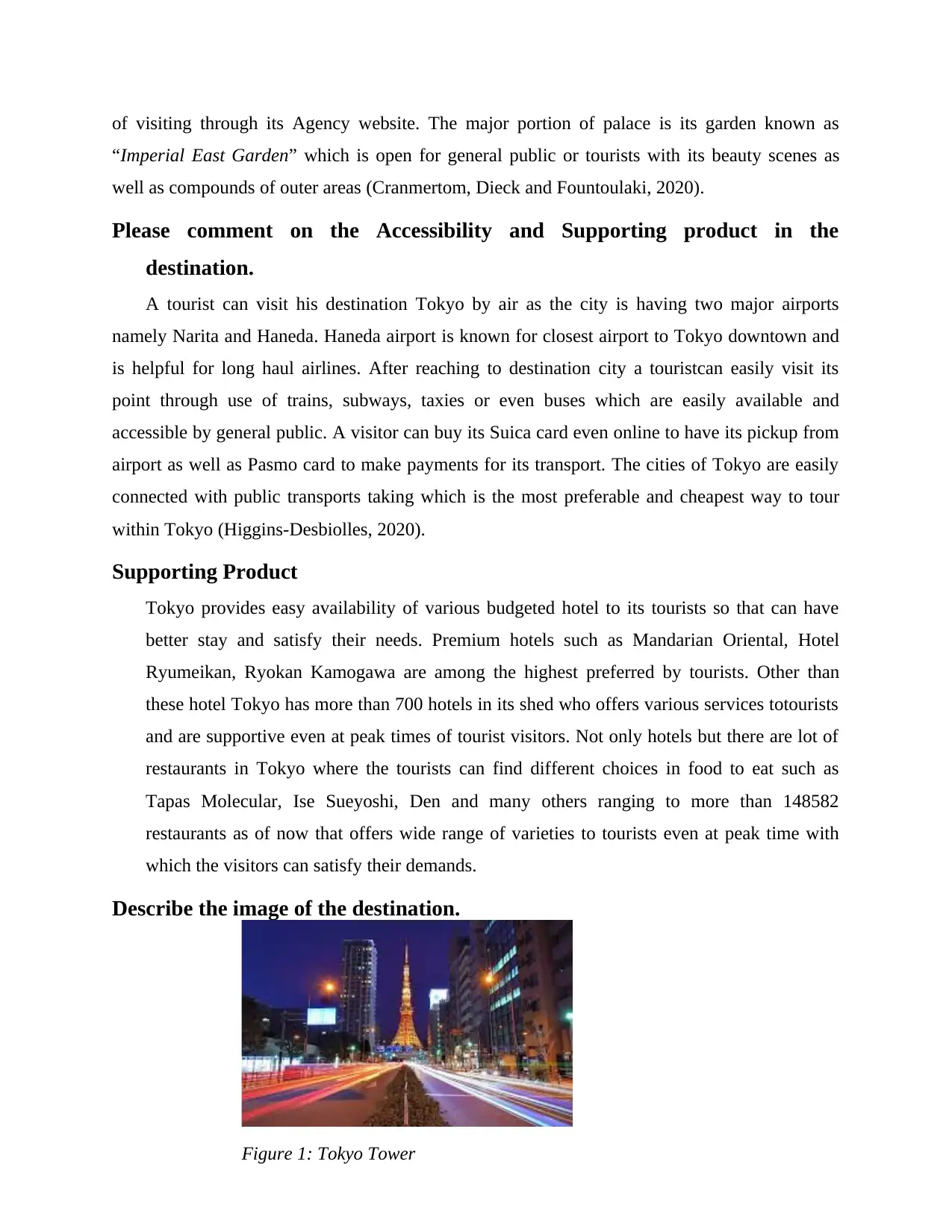
of visiting through its Agency website. The major portion of palace is its garden known as
“Imperial East Garden” which is open for general public or tourists with its beauty scenes as
well as compounds of outer areas (Cranmertom, Dieck and Fountoulaki, 2020).
Please comment on the Accessibility and Supporting product in the
destination.
A tourist can visit his destination Tokyo by air as the city is having two major airports
namely Narita and Haneda. Haneda airport is known for closest airport to Tokyo downtown and
is helpful for long haul airlines. After reaching to destination city a touristcan easily visit its
point through use of trains, subways, taxies or even buses which are easily available and
accessible by general public. A visitor can buy its Suica card even online to have its pickup from
airport as well as Pasmo card to make payments for its transport. The cities of Tokyo are easily
connected with public transports taking which is the most preferable and cheapest way to tour
within Tokyo (Higgins-Desbiolles, 2020).
Supporting Product
Tokyo provides easy availability of various budgeted hotel to its tourists so that can have
better stay and satisfy their needs. Premium hotels such as Mandarian Oriental, Hotel
Ryumeikan, Ryokan Kamogawa are among the highest preferred by tourists. Other than
these hotel Tokyo has more than 700 hotels in its shed who offers various services totourists
and are supportive even at peak times of tourist visitors. Not only hotels but there are lot of
restaurants in Tokyo where the tourists can find different choices in food to eat such as
Tapas Molecular, Ise Sueyoshi, Den and many others ranging to more than 148582
restaurants as of now that offers wide range of varieties to tourists even at peak time with
which the visitors can satisfy their demands.
Describe the image of the destination.
5
Figure 1: Tokyo Tower
“Imperial East Garden” which is open for general public or tourists with its beauty scenes as
well as compounds of outer areas (Cranmertom, Dieck and Fountoulaki, 2020).
Please comment on the Accessibility and Supporting product in the
destination.
A tourist can visit his destination Tokyo by air as the city is having two major airports
namely Narita and Haneda. Haneda airport is known for closest airport to Tokyo downtown and
is helpful for long haul airlines. After reaching to destination city a touristcan easily visit its
point through use of trains, subways, taxies or even buses which are easily available and
accessible by general public. A visitor can buy its Suica card even online to have its pickup from
airport as well as Pasmo card to make payments for its transport. The cities of Tokyo are easily
connected with public transports taking which is the most preferable and cheapest way to tour
within Tokyo (Higgins-Desbiolles, 2020).
Supporting Product
Tokyo provides easy availability of various budgeted hotel to its tourists so that can have
better stay and satisfy their needs. Premium hotels such as Mandarian Oriental, Hotel
Ryumeikan, Ryokan Kamogawa are among the highest preferred by tourists. Other than
these hotel Tokyo has more than 700 hotels in its shed who offers various services totourists
and are supportive even at peak times of tourist visitors. Not only hotels but there are lot of
restaurants in Tokyo where the tourists can find different choices in food to eat such as
Tapas Molecular, Ise Sueyoshi, Den and many others ranging to more than 148582
restaurants as of now that offers wide range of varieties to tourists even at peak time with
which the visitors can satisfy their demands.
Describe the image of the destination.
5
Figure 1: Tokyo Tower
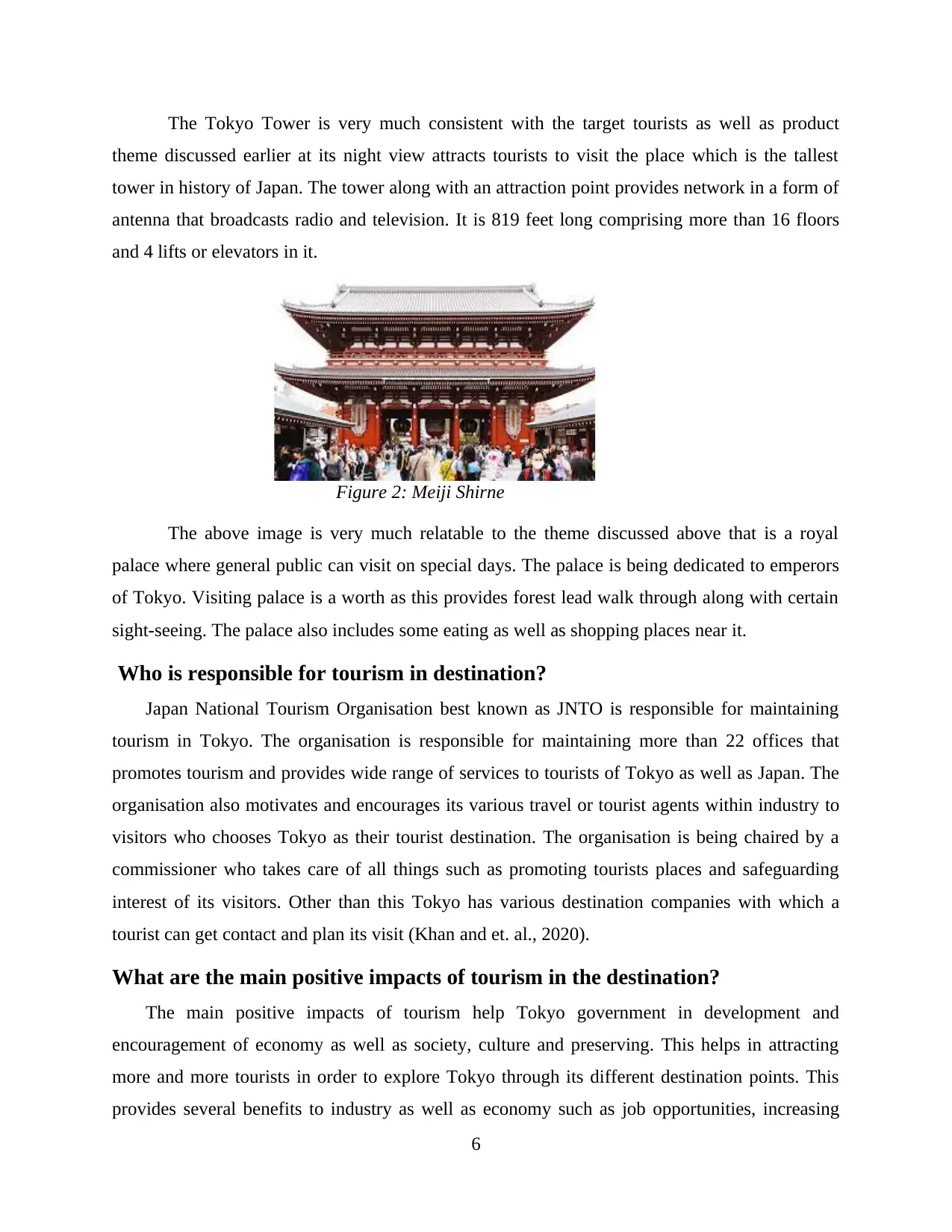
The Tokyo Tower is very much consistent with the target tourists as well as product
theme discussed earlier at its night view attracts tourists to visit the place which is the tallest
tower in history of Japan. The tower along with an attraction point provides network in a form of
antenna that broadcasts radio and television. It is 819 feet long comprising more than 16 floors
and 4 lifts or elevators in it.
Figure 2: Meiji Shirne
The above image is very much relatable to the theme discussed above that is a royal
palace where general public can visit on special days. The palace is being dedicated to emperors
of Tokyo. Visiting palace is a worth as this provides forest lead walk through along with certain
sight-seeing. The palace also includes some eating as well as shopping places near it.
Who is responsible for tourism in destination?
Japan National Tourism Organisation best known as JNTO is responsible for maintaining
tourism in Tokyo. The organisation is responsible for maintaining more than 22 offices that
promotes tourism and provides wide range of services to tourists of Tokyo as well as Japan. The
organisation also motivates and encourages its various travel or tourist agents within industry to
visitors who chooses Tokyo as their tourist destination. The organisation is being chaired by a
commissioner who takes care of all things such as promoting tourists places and safeguarding
interest of its visitors. Other than this Tokyo has various destination companies with which a
tourist can get contact and plan its visit (Khan and et. al., 2020).
What are the main positive impacts of tourism in the destination?
The main positive impacts of tourism help Tokyo government in development and
encouragement of economy as well as society, culture and preserving. This helps in attracting
more and more tourists in order to explore Tokyo through its different destination points. This
provides several benefits to industry as well as economy such as job opportunities, increasing
6
theme discussed earlier at its night view attracts tourists to visit the place which is the tallest
tower in history of Japan. The tower along with an attraction point provides network in a form of
antenna that broadcasts radio and television. It is 819 feet long comprising more than 16 floors
and 4 lifts or elevators in it.
Figure 2: Meiji Shirne
The above image is very much relatable to the theme discussed above that is a royal
palace where general public can visit on special days. The palace is being dedicated to emperors
of Tokyo. Visiting palace is a worth as this provides forest lead walk through along with certain
sight-seeing. The palace also includes some eating as well as shopping places near it.
Who is responsible for tourism in destination?
Japan National Tourism Organisation best known as JNTO is responsible for maintaining
tourism in Tokyo. The organisation is responsible for maintaining more than 22 offices that
promotes tourism and provides wide range of services to tourists of Tokyo as well as Japan. The
organisation also motivates and encourages its various travel or tourist agents within industry to
visitors who chooses Tokyo as their tourist destination. The organisation is being chaired by a
commissioner who takes care of all things such as promoting tourists places and safeguarding
interest of its visitors. Other than this Tokyo has various destination companies with which a
tourist can get contact and plan its visit (Khan and et. al., 2020).
What are the main positive impacts of tourism in the destination?
The main positive impacts of tourism help Tokyo government in development and
encouragement of economy as well as society, culture and preserving. This helps in attracting
more and more tourists in order to explore Tokyo through its different destination points. This
provides several benefits to industry as well as economy such as job opportunities, increasing
6
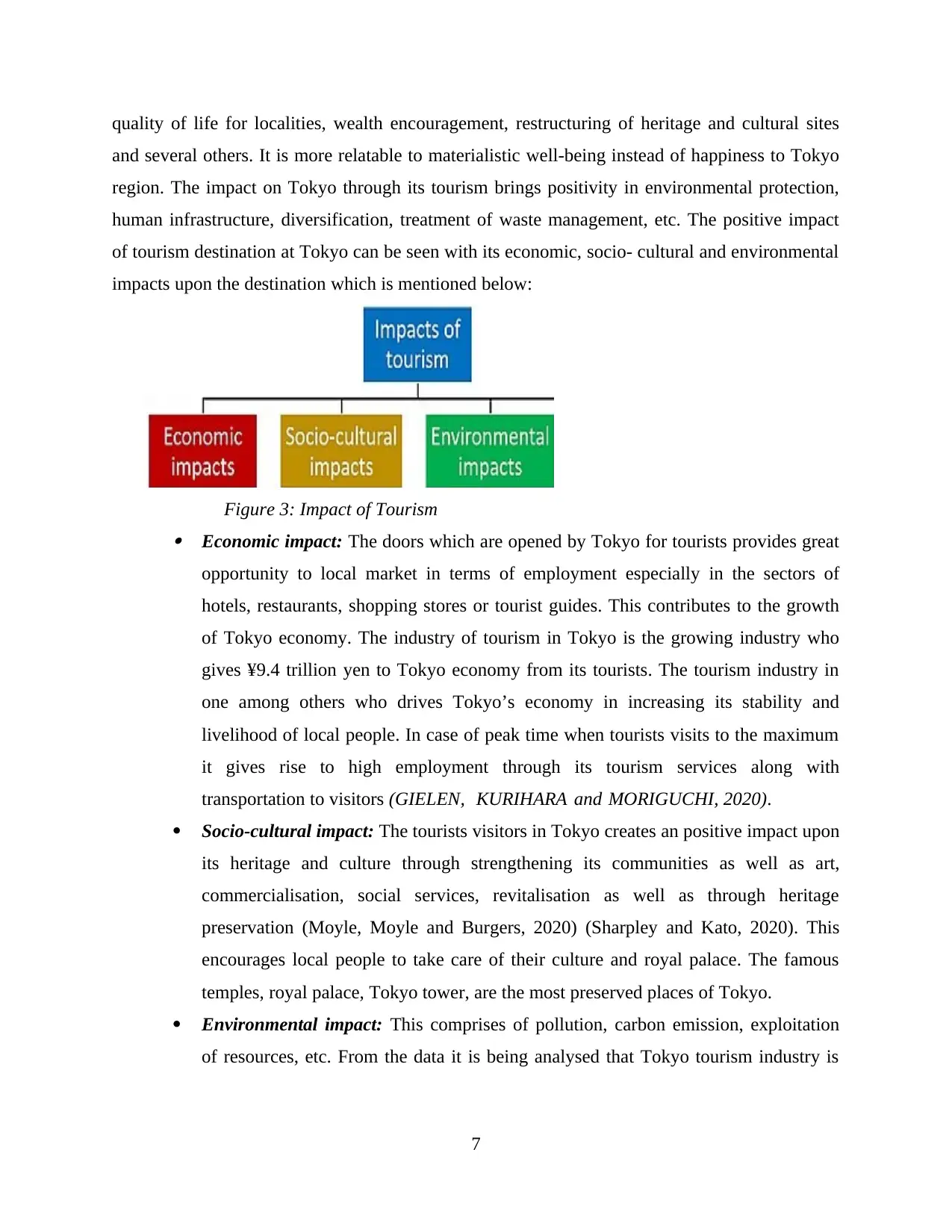
quality of life for localities, wealth encouragement, restructuring of heritage and cultural sites
and several others. It is more relatable to materialistic well-being instead of happiness to Tokyo
region. The impact on Tokyo through its tourism brings positivity in environmental protection,
human infrastructure, diversification, treatment of waste management, etc. The positive impact
of tourism destination at Tokyo can be seen with its economic, socio- cultural and environmental
impacts upon the destination which is mentioned below:
Figure 3: Impact of Tourism
Economic impact: The doors which are opened by Tokyo for tourists provides great
opportunity to local market in terms of employment especially in the sectors of
hotels, restaurants, shopping stores or tourist guides. This contributes to the growth
of Tokyo economy. The industry of tourism in Tokyo is the growing industry who
gives ¥9.4 trillion yen to Tokyo economy from its tourists. The tourism industry in
one among others who drives Tokyo’s economy in increasing its stability and
livelihood of local people. In case of peak time when tourists visits to the maximum
it gives rise to high employment through its tourism services along with
transportation to visitors (GIELEN, KURIHARA and MORIGUCHI, 2020).
Socio-cultural impact: The tourists visitors in Tokyo creates an positive impact upon
its heritage and culture through strengthening its communities as well as art,
commercialisation, social services, revitalisation as well as through heritage
preservation (Moyle, Moyle and Burgers, 2020) (Sharpley and Kato, 2020). This
encourages local people to take care of their culture and royal palace. The famous
temples, royal palace, Tokyo tower, are the most preserved places of Tokyo.
Environmental impact: This comprises of pollution, carbon emission, exploitation
of resources, etc. From the data it is being analysed that Tokyo tourism industry is
7
and several others. It is more relatable to materialistic well-being instead of happiness to Tokyo
region. The impact on Tokyo through its tourism brings positivity in environmental protection,
human infrastructure, diversification, treatment of waste management, etc. The positive impact
of tourism destination at Tokyo can be seen with its economic, socio- cultural and environmental
impacts upon the destination which is mentioned below:
Figure 3: Impact of Tourism
Economic impact: The doors which are opened by Tokyo for tourists provides great
opportunity to local market in terms of employment especially in the sectors of
hotels, restaurants, shopping stores or tourist guides. This contributes to the growth
of Tokyo economy. The industry of tourism in Tokyo is the growing industry who
gives ¥9.4 trillion yen to Tokyo economy from its tourists. The tourism industry in
one among others who drives Tokyo’s economy in increasing its stability and
livelihood of local people. In case of peak time when tourists visits to the maximum
it gives rise to high employment through its tourism services along with
transportation to visitors (GIELEN, KURIHARA and MORIGUCHI, 2020).
Socio-cultural impact: The tourists visitors in Tokyo creates an positive impact upon
its heritage and culture through strengthening its communities as well as art,
commercialisation, social services, revitalisation as well as through heritage
preservation (Moyle, Moyle and Burgers, 2020) (Sharpley and Kato, 2020). This
encourages local people to take care of their culture and royal palace. The famous
temples, royal palace, Tokyo tower, are the most preserved places of Tokyo.
Environmental impact: This comprises of pollution, carbon emission, exploitation
of resources, etc. From the data it is being analysed that Tokyo tourism industry is
7
Paraphrase This Document
Need a fresh take? Get an instant paraphrase of this document with our AI Paraphraser
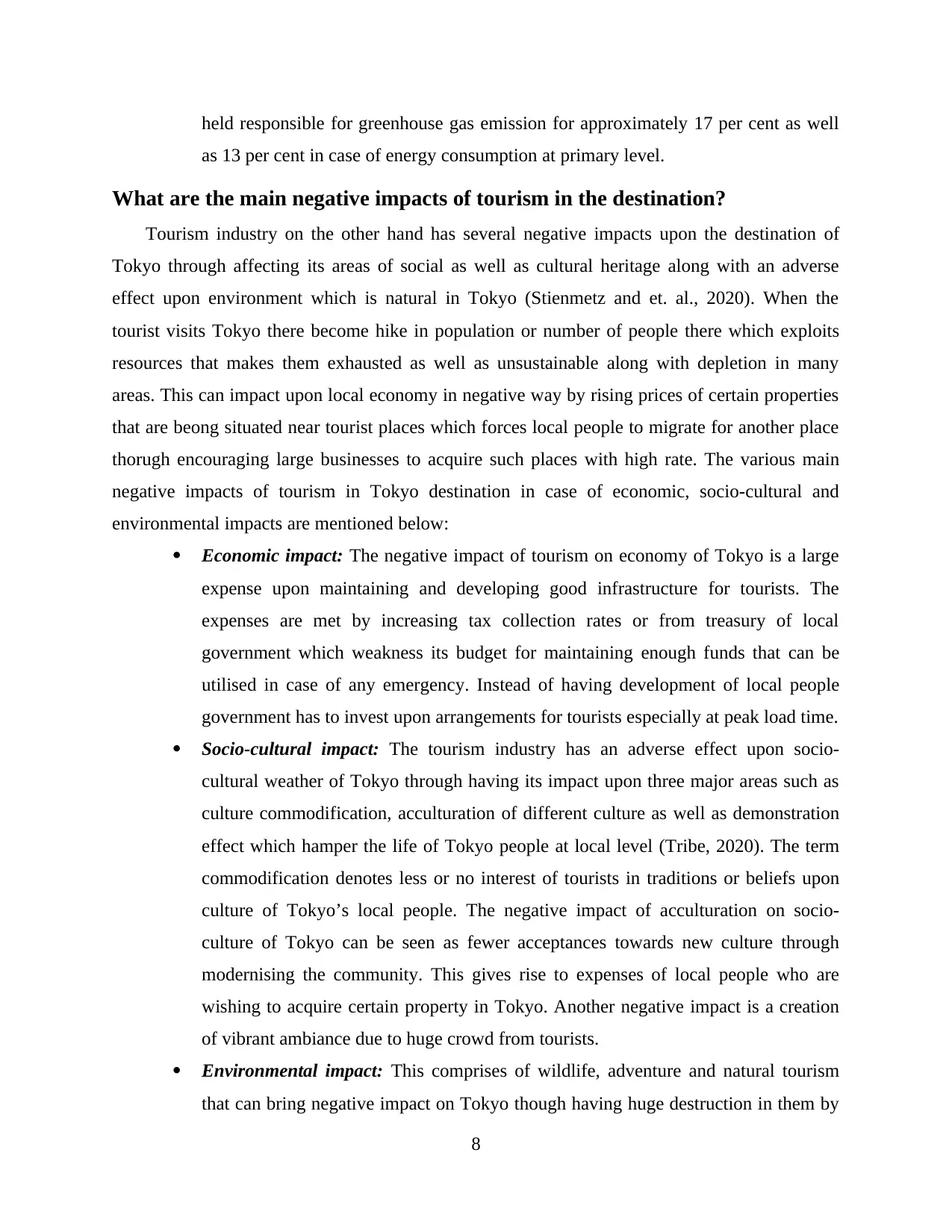
held responsible for greenhouse gas emission for approximately 17 per cent as well
as 13 per cent in case of energy consumption at primary level.
What are the main negative impacts of tourism in the destination?
Tourism industry on the other hand has several negative impacts upon the destination of
Tokyo through affecting its areas of social as well as cultural heritage along with an adverse
effect upon environment which is natural in Tokyo (Stienmetz and et. al., 2020). When the
tourist visits Tokyo there become hike in population or number of people there which exploits
resources that makes them exhausted as well as unsustainable along with depletion in many
areas. This can impact upon local economy in negative way by rising prices of certain properties
that are beong situated near tourist places which forces local people to migrate for another place
thorugh encouraging large businesses to acquire such places with high rate. The various main
negative impacts of tourism in Tokyo destination in case of economic, socio-cultural and
environmental impacts are mentioned below:
Economic impact: The negative impact of tourism on economy of Tokyo is a large
expense upon maintaining and developing good infrastructure for tourists. The
expenses are met by increasing tax collection rates or from treasury of local
government which weakness its budget for maintaining enough funds that can be
utilised in case of any emergency. Instead of having development of local people
government has to invest upon arrangements for tourists especially at peak load time.
Socio-cultural impact: The tourism industry has an adverse effect upon socio-
cultural weather of Tokyo through having its impact upon three major areas such as
culture commodification, acculturation of different culture as well as demonstration
effect which hamper the life of Tokyo people at local level (Tribe, 2020). The term
commodification denotes less or no interest of tourists in traditions or beliefs upon
culture of Tokyo’s local people. The negative impact of acculturation on socio-
culture of Tokyo can be seen as fewer acceptances towards new culture through
modernising the community. This gives rise to expenses of local people who are
wishing to acquire certain property in Tokyo. Another negative impact is a creation
of vibrant ambiance due to huge crowd from tourists.
Environmental impact: This comprises of wildlife, adventure and natural tourism
that can bring negative impact on Tokyo though having huge destruction in them by
8
as 13 per cent in case of energy consumption at primary level.
What are the main negative impacts of tourism in the destination?
Tourism industry on the other hand has several negative impacts upon the destination of
Tokyo through affecting its areas of social as well as cultural heritage along with an adverse
effect upon environment which is natural in Tokyo (Stienmetz and et. al., 2020). When the
tourist visits Tokyo there become hike in population or number of people there which exploits
resources that makes them exhausted as well as unsustainable along with depletion in many
areas. This can impact upon local economy in negative way by rising prices of certain properties
that are beong situated near tourist places which forces local people to migrate for another place
thorugh encouraging large businesses to acquire such places with high rate. The various main
negative impacts of tourism in Tokyo destination in case of economic, socio-cultural and
environmental impacts are mentioned below:
Economic impact: The negative impact of tourism on economy of Tokyo is a large
expense upon maintaining and developing good infrastructure for tourists. The
expenses are met by increasing tax collection rates or from treasury of local
government which weakness its budget for maintaining enough funds that can be
utilised in case of any emergency. Instead of having development of local people
government has to invest upon arrangements for tourists especially at peak load time.
Socio-cultural impact: The tourism industry has an adverse effect upon socio-
cultural weather of Tokyo through having its impact upon three major areas such as
culture commodification, acculturation of different culture as well as demonstration
effect which hamper the life of Tokyo people at local level (Tribe, 2020). The term
commodification denotes less or no interest of tourists in traditions or beliefs upon
culture of Tokyo’s local people. The negative impact of acculturation on socio-
culture of Tokyo can be seen as fewer acceptances towards new culture through
modernising the community. This gives rise to expenses of local people who are
wishing to acquire certain property in Tokyo. Another negative impact is a creation
of vibrant ambiance due to huge crowd from tourists.
Environmental impact: This comprises of wildlife, adventure and natural tourism
that can bring negative impact on Tokyo though having huge destruction in them by
8
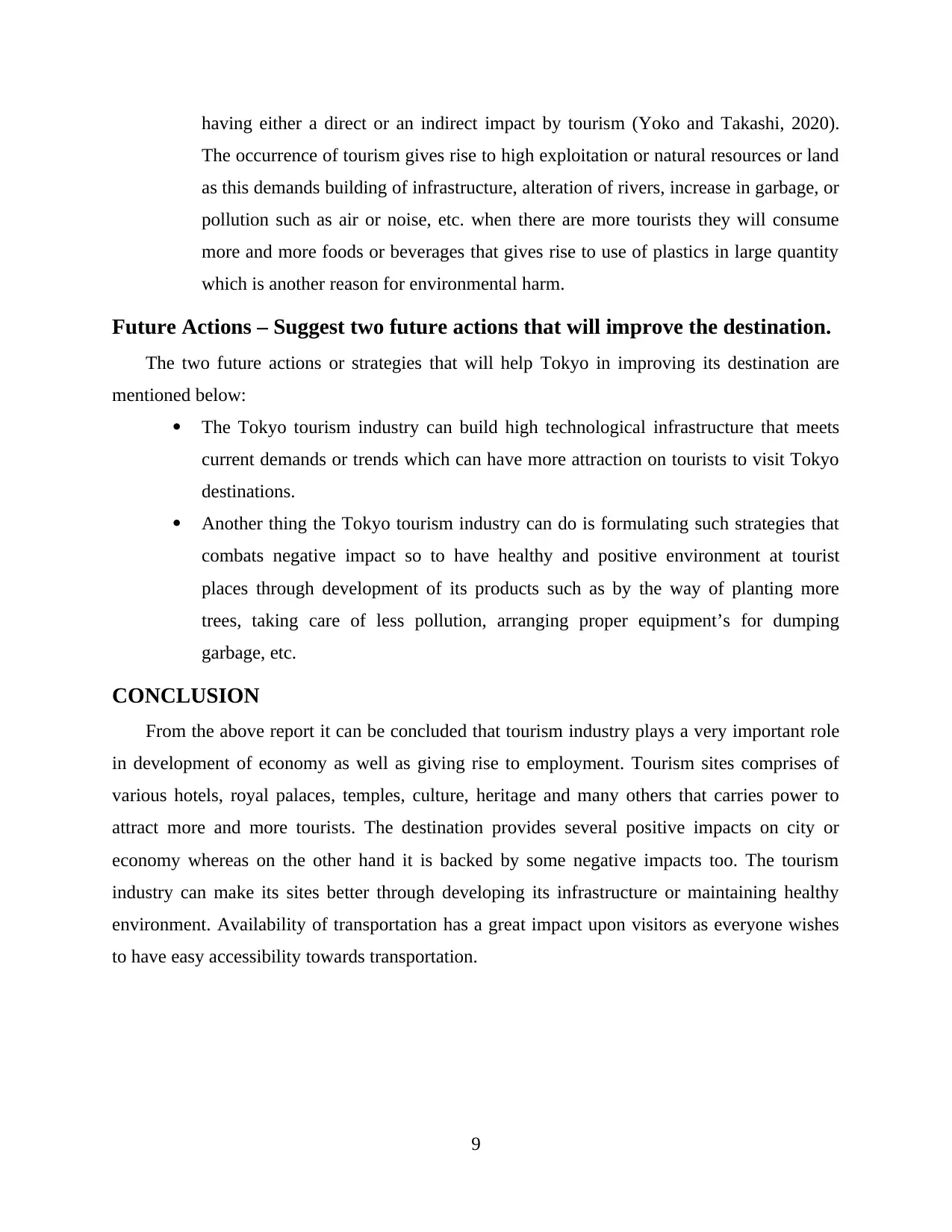
having either a direct or an indirect impact by tourism (Yoko and Takashi, 2020).
The occurrence of tourism gives rise to high exploitation or natural resources or land
as this demands building of infrastructure, alteration of rivers, increase in garbage, or
pollution such as air or noise, etc. when there are more tourists they will consume
more and more foods or beverages that gives rise to use of plastics in large quantity
which is another reason for environmental harm.
Future Actions – Suggest two future actions that will improve the destination.
The two future actions or strategies that will help Tokyo in improving its destination are
mentioned below:
The Tokyo tourism industry can build high technological infrastructure that meets
current demands or trends which can have more attraction on tourists to visit Tokyo
destinations.
Another thing the Tokyo tourism industry can do is formulating such strategies that
combats negative impact so to have healthy and positive environment at tourist
places through development of its products such as by the way of planting more
trees, taking care of less pollution, arranging proper equipment’s for dumping
garbage, etc.
CONCLUSION
From the above report it can be concluded that tourism industry plays a very important role
in development of economy as well as giving rise to employment. Tourism sites comprises of
various hotels, royal palaces, temples, culture, heritage and many others that carries power to
attract more and more tourists. The destination provides several positive impacts on city or
economy whereas on the other hand it is backed by some negative impacts too. The tourism
industry can make its sites better through developing its infrastructure or maintaining healthy
environment. Availability of transportation has a great impact upon visitors as everyone wishes
to have easy accessibility towards transportation.
9
The occurrence of tourism gives rise to high exploitation or natural resources or land
as this demands building of infrastructure, alteration of rivers, increase in garbage, or
pollution such as air or noise, etc. when there are more tourists they will consume
more and more foods or beverages that gives rise to use of plastics in large quantity
which is another reason for environmental harm.
Future Actions – Suggest two future actions that will improve the destination.
The two future actions or strategies that will help Tokyo in improving its destination are
mentioned below:
The Tokyo tourism industry can build high technological infrastructure that meets
current demands or trends which can have more attraction on tourists to visit Tokyo
destinations.
Another thing the Tokyo tourism industry can do is formulating such strategies that
combats negative impact so to have healthy and positive environment at tourist
places through development of its products such as by the way of planting more
trees, taking care of less pollution, arranging proper equipment’s for dumping
garbage, etc.
CONCLUSION
From the above report it can be concluded that tourism industry plays a very important role
in development of economy as well as giving rise to employment. Tourism sites comprises of
various hotels, royal palaces, temples, culture, heritage and many others that carries power to
attract more and more tourists. The destination provides several positive impacts on city or
economy whereas on the other hand it is backed by some negative impacts too. The tourism
industry can make its sites better through developing its infrastructure or maintaining healthy
environment. Availability of transportation has a great impact upon visitors as everyone wishes
to have easy accessibility towards transportation.
9
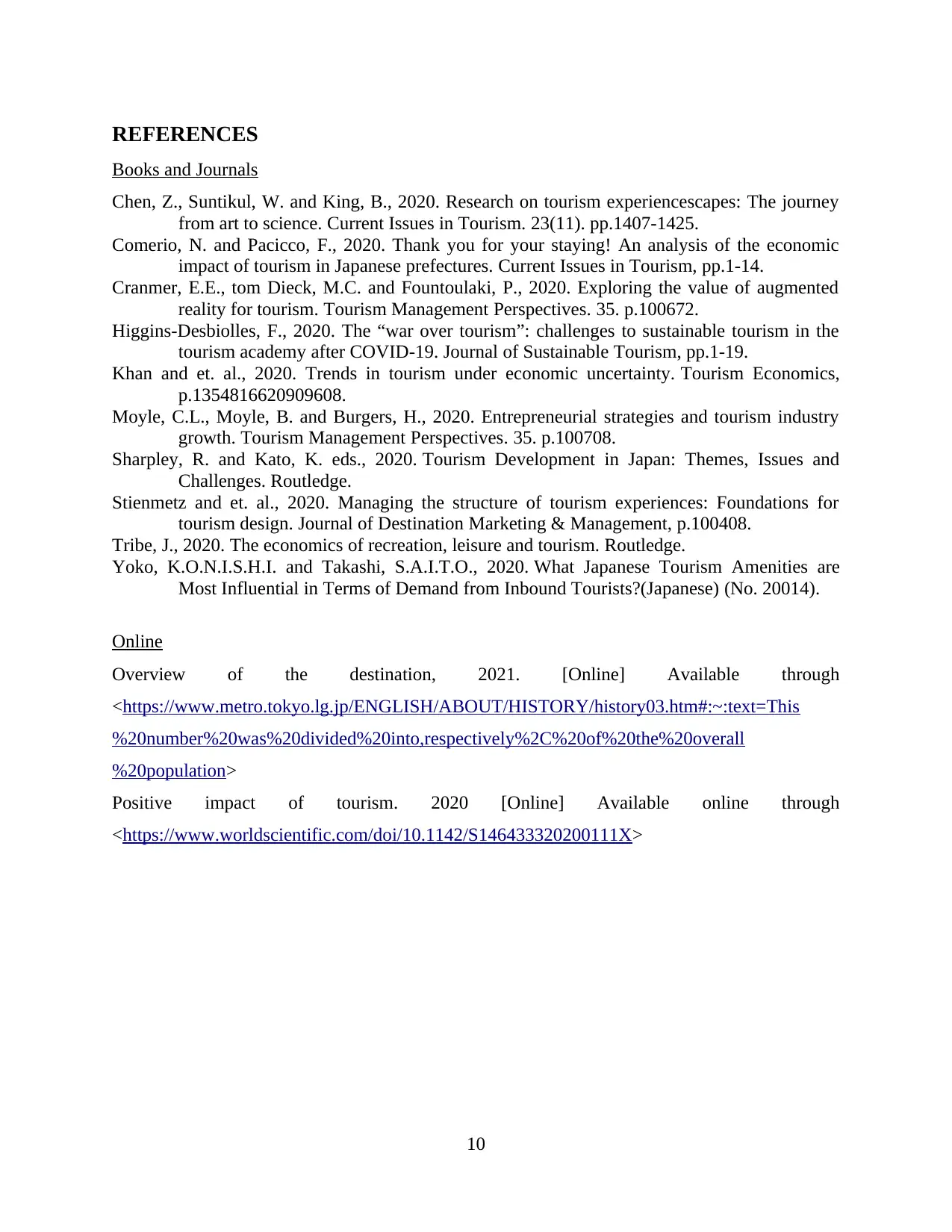
REFERENCES
Books and Journals
Chen, Z., Suntikul, W. and King, B., 2020. Research on tourism experiencescapes: The journey
from art to science. Current Issues in Tourism. 23(11). pp.1407-1425.
Comerio, N. and Pacicco, F., 2020. Thank you for your staying! An analysis of the economic
impact of tourism in Japanese prefectures. Current Issues in Tourism, pp.1-14.
Cranmer, E.E., tom Dieck, M.C. and Fountoulaki, P., 2020. Exploring the value of augmented
reality for tourism. Tourism Management Perspectives. 35. p.100672.
Higgins-Desbiolles, F., 2020. The “war over tourism”: challenges to sustainable tourism in the
tourism academy after COVID-19. Journal of Sustainable Tourism, pp.1-19.
Khan and et. al., 2020. Trends in tourism under economic uncertainty. Tourism Economics,
p.1354816620909608.
Moyle, C.L., Moyle, B. and Burgers, H., 2020. Entrepreneurial strategies and tourism industry
growth. Tourism Management Perspectives. 35. p.100708.
Sharpley, R. and Kato, K. eds., 2020. Tourism Development in Japan: Themes, Issues and
Challenges. Routledge.
Stienmetz and et. al., 2020. Managing the structure of tourism experiences: Foundations for
tourism design. Journal of Destination Marketing & Management, p.100408.
Tribe, J., 2020. The economics of recreation, leisure and tourism. Routledge.
Yoko, K.O.N.I.S.H.I. and Takashi, S.A.I.T.O., 2020. What Japanese Tourism Amenities are
Most Influential in Terms of Demand from Inbound Tourists?(Japanese) (No. 20014).
Online
Overview of the destination, 2021. [Online] Available through
<https://www.metro.tokyo.lg.jp/ENGLISH/ABOUT/HISTORY/history03.htm#:~:text=This
%20number%20was%20divided%20into,respectively%2C%20of%20the%20overall
%20population>
Positive impact of tourism. 2020 [Online] Available online through
<https://www.worldscientific.com/doi/10.1142/S146433320200111X>
10
Books and Journals
Chen, Z., Suntikul, W. and King, B., 2020. Research on tourism experiencescapes: The journey
from art to science. Current Issues in Tourism. 23(11). pp.1407-1425.
Comerio, N. and Pacicco, F., 2020. Thank you for your staying! An analysis of the economic
impact of tourism in Japanese prefectures. Current Issues in Tourism, pp.1-14.
Cranmer, E.E., tom Dieck, M.C. and Fountoulaki, P., 2020. Exploring the value of augmented
reality for tourism. Tourism Management Perspectives. 35. p.100672.
Higgins-Desbiolles, F., 2020. The “war over tourism”: challenges to sustainable tourism in the
tourism academy after COVID-19. Journal of Sustainable Tourism, pp.1-19.
Khan and et. al., 2020. Trends in tourism under economic uncertainty. Tourism Economics,
p.1354816620909608.
Moyle, C.L., Moyle, B. and Burgers, H., 2020. Entrepreneurial strategies and tourism industry
growth. Tourism Management Perspectives. 35. p.100708.
Sharpley, R. and Kato, K. eds., 2020. Tourism Development in Japan: Themes, Issues and
Challenges. Routledge.
Stienmetz and et. al., 2020. Managing the structure of tourism experiences: Foundations for
tourism design. Journal of Destination Marketing & Management, p.100408.
Tribe, J., 2020. The economics of recreation, leisure and tourism. Routledge.
Yoko, K.O.N.I.S.H.I. and Takashi, S.A.I.T.O., 2020. What Japanese Tourism Amenities are
Most Influential in Terms of Demand from Inbound Tourists?(Japanese) (No. 20014).
Online
Overview of the destination, 2021. [Online] Available through
<https://www.metro.tokyo.lg.jp/ENGLISH/ABOUT/HISTORY/history03.htm#:~:text=This
%20number%20was%20divided%20into,respectively%2C%20of%20the%20overall
%20population>
Positive impact of tourism. 2020 [Online] Available online through
<https://www.worldscientific.com/doi/10.1142/S146433320200111X>
10
1 out of 10
Related Documents
Your All-in-One AI-Powered Toolkit for Academic Success.
+13062052269
info@desklib.com
Available 24*7 on WhatsApp / Email
![[object Object]](/_next/static/media/star-bottom.7253800d.svg)
Unlock your academic potential
© 2024 | Zucol Services PVT LTD | All rights reserved.





